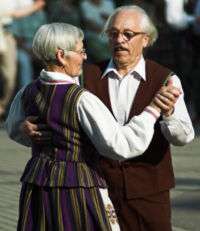Activity theory (aging)

The activity theory, also known as the implicit theory of ageing, normal theory of ageing, and lay theory of ageing,[1] proposes that successful ageing occurs when older adults stay active and maintain social interactions. It takes the view that the ageing process is delayed and the quality of life is enhanced when old people remain socially active.[2] The activity theory rose in opposing response to the disengagement theory.[3] The activity theory and the disengagement theory were the two major theories that outlined successful ageing in the early 1960s.[2] The theory was developed by Robert J. Havighurst in 1961.[1][4] In 1964, Bernice Neugarten asserted that satisfaction in old age depended on active maintenance of personal relationships and endeavors.[3]
The theory assumes that a positive relationship between activity and life satisfaction.[1] One author suggests that activity enables older adults adjust to retirement and is named “the busy ethic”.[5]
The critics of the activity theory state that it overlooks inequalities in health and economics that hinders the ability for older people to engage in such activities.[3] Also, some older adults do not desire to engage in new challenges.[3]
Activity theory reflects the functionalist perspective that the equilibrium that an individual develops in middle age should be maintained in later years.[2] The theory predicts that older adults that face role loss will substitute former roles with other alternatives.[2]
The activity theory is one of three major psychosocial theories which describe how people develop in old age.[6] The other two psychosocial theories are the disengagement theory, with which the activity comes to odds, and the continuity theory which modifies and elaborates upon the activity theory.
Though in recent years the acceptance activity theory has diminished, it is still used as a standard to compare observed activity and life satisfaction patterns.[2]
See also
References
- 1 2 3 Sana Loue; Martha Sajatovic (16 January 2008). Encyclopedia of Ageing and Public Health. Springer. pp. 79–81. ISBN 978-0-387-33753-1. Retrieved 4 June 2011.
- 1 2 3 4 5 Richard Schulz (2006). The Encyclopedia of Ageing: A-K. Springer Publishing Company. pp. 9–13. ISBN 978-0-8261-4843-8. Retrieved 4 June 2011.
- 1 2 3 4 Vern L. Bengtson; Norella Putney (2009). Handbook of theories of ageing. Springer Publishing Company. p. 32. ISBN 978-0-8261-6251-9. Retrieved 4 June 2011.
- ↑ Havighurst, R. J. (1961). "Successful ageing". The Gerontologist. 1: 8–13. doi:10.1093/geront/1.1.8.
- ↑ Ekerdt, D. J. (1986). "The busy ethic: Moral continuity between work and retirement". The Gerontologist. 26 (3): 239–244. doi:10.1093/geront/26.3.239.
- ↑ Priscilla Ebersole (8 April 2005). Gerontological nursing and healthy aging. Elsevier Health Sciences. p. 108. ISBN 978-0-323-03165-3. Retrieved 4 June 2011.